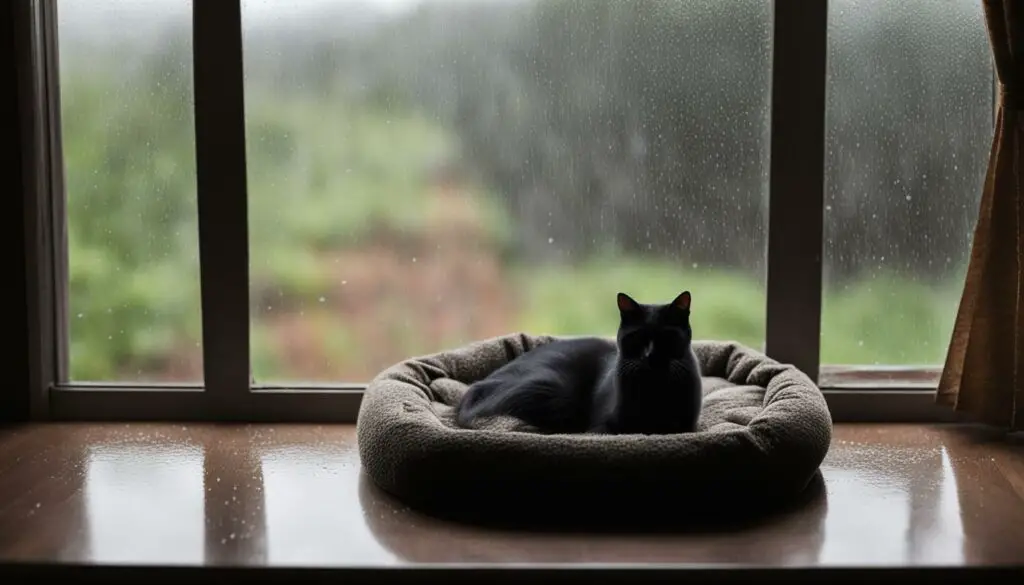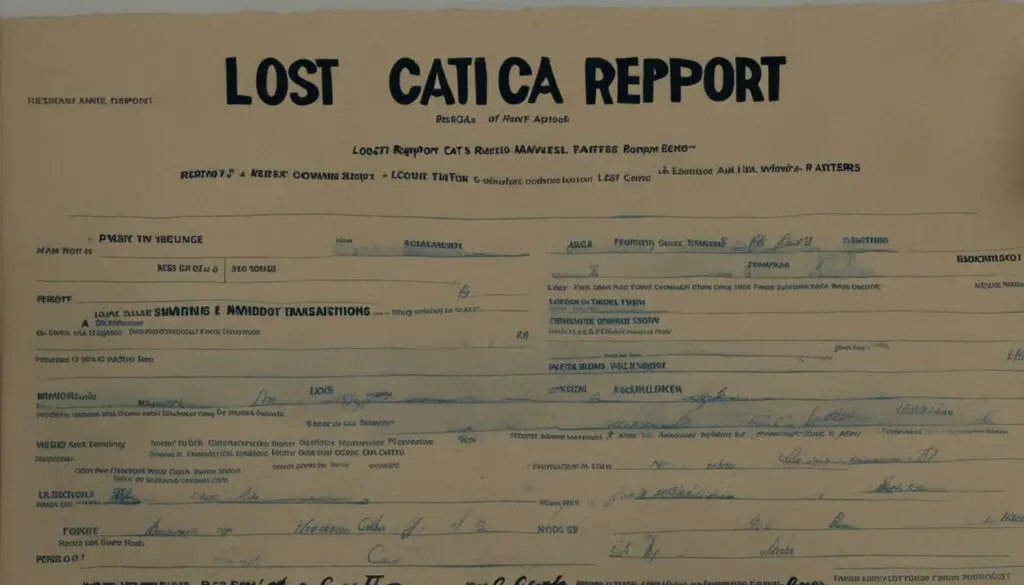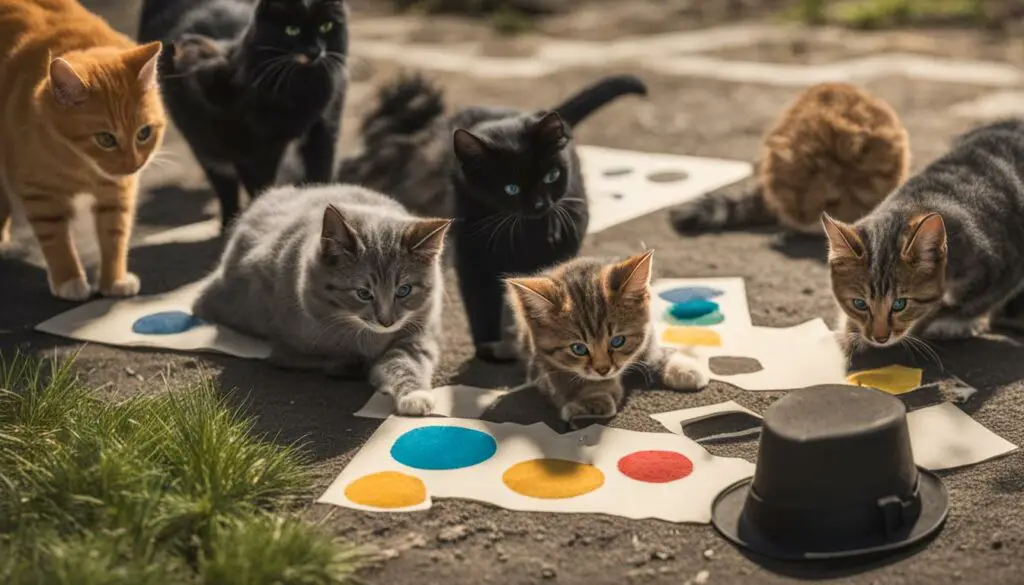It’s been 2 weeks since my cat went missing and I’m desperate to find her. I’ve tried various search methods such as searching the entire house, walking the streets, using humane traps, putting up posters, and more. I’ve even updated her microchip information and reached out on social media and missing pet sites. But despite my efforts, she hasn’t been found yet. In this article, I’ll share my journey and explore practical tips and resources to help find a missing pet.
Key Takeaways:
- Stay determined and proactive in your search efforts.
- Understanding the reasons why cats go missing can help narrow down search efforts.
- The duration of a cat’s disappearance can vary, but don’t give up hope.
- A microchip can assist in the return of a lost cat if found by someone else.
- Indoor cats are more likely to stay close to home when they go missing.
Reasons Why Cats Go Missing
When it comes to cat disappearances, there can be several reasons behind them. Cats, as curious creatures, are prone to wandering and exploring their territory. Unneutered cats may venture out in search of a mate, while others may be lured by friendly neighbors who offer them food and attention. Understanding these reasons is crucial in narrowing down search efforts and gaining insight into their behavior.
While some may argue that cats are simply independent by nature, their disappearance can also be influenced by external factors such as changes in their environment, stress, fear, or even unintentional escapes through open doors or windows. All these factors contribute to the complex nature of feline behavior and the potential for them to go missing.
By recognizing these reasons, cat owners can strategize their search efforts and focus on areas where their cat may be more likely to be found. It’s important to remember that each cat is unique, and their behavior may differ based on their personality, experiences, and individual circumstances. Employing a combination of search methods and understanding feline behavior can increase the chances of a successful reunion.

Reasons Why Cats Go Missing
| Reasons | Description |
|---|---|
| Mating | Unneutered cats may wander in search of a mate. |
| Curiosity | Cats are curious creatures and love to explore their territory. |
| Attracted by Food | Some cats may be lured by friendly neighbors who offer them food and attention. |
| Environmental Changes | Changes in the environment, stress, or fear can contribute to their disappearance. |
| Unintentional Escapes | Cats may accidentally escape through open doors or windows. |
How Long Cats Go Missing For
When a beloved cat goes missing, it can be an incredibly distressing experience for any cat owner. The length of time a cat remains missing can vary greatly, causing anxiety and uncertainty. While some cats may return home within a day or two, others may be gone for weeks or even months. As a cat owner, it’s important to stay determined and continue search efforts for a longer period, as there have been cases where cats have been reunited with their owners after an extended period of time.
It’s important to remember that cats are resilient and resourceful animals. They have natural instincts that help them survive, even when they are away from their familiar surroundings. They may hide in secluded areas, seek shelter, or even find food sources on their own. This is why it’s crucial for cat owners to never give up hope and continue searching, even as time goes by.
While the chances of finding a lost cat may decrease after 90 days, it’s still possible to reunite with them. There have been heartwarming stories of cats being found months, or even years, after they initially went missing. The key is to remain persistent and use a variety of search methods, such as distributing flyers, posting on social media, contacting local shelters, and engaging the community for support.

Factors to Consider
Several factors can influence the duration of a cat’s disappearance. These include the cat’s personality, the circumstances surrounding their disappearance, and the environment in which they went missing. For example, an adventurous and confident cat may explore further from home and remain missing for a longer period. On the other hand, a shy or timid cat may seek shelter nearby and eventually be found closer to home.
It’s also important to consider the efforts made by cat owners in actively searching for their missing pet. The more proactive and persistent the search efforts, the greater the chances of a successful reunion. By utilizing various search methods, reaching out for help, and spreading the word, cat owners can significantly increase the likelihood of finding their missing feline friend.
Tips for Finding a Lost Cat with a Microchip
If your cat has a microchip, it can be a valuable tool in reuniting you with your furry friend. While the microchip itself doesn’t actively help in searching for a lost cat, it can greatly assist in their return if someone finds them and takes them to a shelter or vet. Here are some tips for utilizing a microchip to find a lost cat:
- Ensure the microchip information is up to date: Make sure your contact information registered with the microchip is current. This includes your phone number, address, and email. If any changes have occurred since the microchip was implanted, contact the microchip company to update your details.
- Register the microchip with a pet chip registry: In addition to updating your contact information with the microchip company, it’s also a good idea to register the microchip with a pet chip registry. This increases the chances of someone scanning the microchip and being able to contact you if your lost cat is found.
- Report your cat as missing to the microchip company: Contact the microchip company and inform them that your cat is missing. They may be able to provide additional resources or guidance in finding your cat. They can also flag your cat’s microchip as missing, which can be helpful if someone scans the microchip and contacts the company.
- Continue using other search methods: While a microchip can be a valuable tool, it’s important to remember that it shouldn’t be relied upon as the sole method of finding your lost cat. Continue using other search methods such as searching your neighborhood, putting up posters, contacting local shelters, and engaging the community in the search efforts.
By combining the power of a microchip with other search methods, you can increase the chances of being reunited with your beloved cat.
Tips for Finding a Lost Cat with a Microchip
| Tip | Description |
|---|---|
| Ensure microchip information is up to date | Make sure your contact details registered with the microchip company are current. |
| Register the microchip with a pet chip registry | Increase the chances of someone contacting you if your lost cat is found. |
| Report your cat as missing to the microchip company | Inform the company and utilize their resources in the search efforts. |
| Continue using other search methods | Combine the power of a microchip with other search methods to maximize your chances of finding your lost cat. |
Remember, a microchip is a valuable tool, but it should be used in conjunction with other search methods to increase the likelihood of a successful reunion with your missing cat.
![]()
Searching for an Indoor Cat
When an indoor cat goes missing, it can be particularly distressing. Indoor cats tend to have a smaller territory and are more likely to stay close to home. Therefore, searching indoors is crucial in finding a lost indoor cat. Here are some tips to help you in your search:
1. Check Every Nook and Cranny
Indoor cats are masters at finding hiding spots, so be sure to check every nook and cranny in your home. Look under beds, inside closets, behind furniture, and even in small spaces like laundry baskets or under the stairs. Cats can squeeze into surprisingly tight spaces, so be thorough in your search.
2. Use Tempting Scents and Sounds
Try enticing your cat out of hiding by using familiar scents and sounds. You can set up their favorite scratching post or cat bed in a central location and place some treats or toys nearby. The familiar scents may encourage them to come out of hiding. Additionally, you can play recordings of their favorite sounds, such as the sound of birds chirping or mice squeaking, to entice them to come closer.
3. Employ the Element of Surprise
If your indoor cat is particularly timid or skittish, you may need to use the element of surprise to coax them out of hiding. This can be done by making sudden, unexpected noises or movements. For example, you can shake a treat bag or rustle a toy to get their attention. Be patient and persistent in your efforts, as it may take some time for your cat to feel comfortable enough to come out.
Remember, indoor cats are more likely to be hiding somewhere in your home, so it’s important to thoroughly search every area. By following these tips, you can increase the chances of finding your lost indoor cat and bringing them back home where they belong.

Conducting a Physical Search
When it comes to finding a lost cat, conducting a physical search is essential. Waiting for them to return on their own isn’t always enough, so taking proactive steps can significantly increase your chances of locating your feline friend. Here are some tips for conducting a thorough physical search:
- Start Immediately: As soon as you realize your cat is missing, begin your search. Time is of the essence, as cats can quickly wander far from home.
- Search Thoroughly: Cats are often found within 500 meters of where they escaped, so search every corner of your property and nearby areas. Look in hiding spots such as under bushes, in sheds, or even up trees.
- Get Others Involved: Enlist the help of friends, family, and neighbors in the search efforts. More people searching means more eyes and a greater chance of finding your cat.
- Use a Lost Pet Report: File a lost pet report with local animal shelters and veterinarians. Provide them with a detailed description and a recent photo of your cat. Regularly follow up with them for any updates or sightings.
Remember, conducting a physical search requires persistence and determination. Keep searching until you bring your beloved cat back home.

Table: Physical Search Checklist
| Steps | Description |
|---|---|
| Start Immediately | Begin the search as soon as you realize your cat is missing. Time is crucial. |
| Search Thoroughly | Check every corner of your property, nearby areas, and all potential hiding spots. |
| Get Others Involved | Enlist the help of friends, family, and neighbors to maximize the search efforts. |
| Use a Lost Pet Report | File a report with local animal shelters and veterinarians, providing them with detailed information and a recent photo of your cat. |
Using a GPS Cat Tracker
A GPS cat tracker can be a valuable tool in the search for a lost cat. With real-time tracking capabilities, it can help locate your feline friend, especially if they are hiding or have traveled far from home. By attaching a GPS tracker to your cat’s collar, you can monitor their movements and pinpoint their exact location.
One of the advantages of using a GPS cat tracker is the ability to set up virtual boundaries. You can create safe zones around your home and receive alerts if your cat crosses these boundaries. This feature ensures that you’re immediately notified if your cat roams too far, allowing you to take swift action.
Additionally, GPS trackers provide peace of mind during the search process. Knowing that you can track your cat’s location at any time can help alleviate anxiety and allow you to focus on other search efforts. It’s important to remember that a GPS cat tracker should be used in conjunction with other search methods, such as physical searches and community engagement.
![]()
Table: Comparison of GPS Cat Trackers
| Brand | Features | Price |
|---|---|---|
| PetFon GPS Tracker | Real-time tracking, virtual fence, waterproof | $99.99 |
| Whistle GO Explore | Activity monitoring, health insights, waterproof | $129.95 |
| Tractive GPS Tracker | Live tracking, geofence, worldwide coverage | $49.99 |
When choosing a GPS cat tracker, consider factors such as battery life, range, and ease of use. Read customer reviews and compare different models to find the one that best suits your needs. Remember to ensure that the tracker is securely attached to your cat’s collar to prevent it from getting lost.
While a GPS cat tracker can be a valuable tool in the search for a missing cat, it’s essential to combine it with other methods and actively engage in the search efforts. By utilizing technology and implementing a comprehensive approach, you can maximize your chances of finding your beloved feline companion.
Luring Out a Lost Cat
When a cat goes missing, it can be a distressing experience for both the cat owner and the furry friend. Luring out a lost cat requires patience, persistence, and strategic tactics. Here are some effective methods to entice a lost cat to come out of hiding and increase the chances of a successful rescue.
Leaving out Tempting Treats and Food
Cats are motivated by their stomachs, so leaving out their favorite treats or food near your home can be a powerful incentive for them to return. Place the treats or food in areas where they are likely to frequent, such as near their usual food bowl or in their favorite hiding spots. The familiar scents and enticing aromas may lure them out of their hiding place and back to safety.
Creating a Safe and Cozy Area
Lost cats are often scared and anxious, which may cause them to seek out safe and secluded areas. To encourage them to come out, create a calm and inviting space for them. Set up a cozy area with familiar scents, such as their favorite blanket or bedding, in a quiet and secure location. This can provide them with a sense of comfort and familiarity, making them more likely to venture out and return home.
Opening Doors and Windows
Providing potential escape routes can be a useful tactic in luring out a lost cat. Leave doors or windows open, but ensure they are secure enough to prevent other animals from entering. Creating an easy pathway for your cat to return can be an effective way to entice them back home. Be patient and attentive, as they may need time to gather the confidence to explore the open exit.
Remember, every lost cat is unique, and their response to these tactics may vary. It’s important to remain calm, consistent, and persistent in your efforts to lure them out. By utilizing these methods, you can increase the chances of a successful rescue and reunite with your beloved feline companion.

Making Use of Lost Cat Posters and Social Media
When a beloved cat goes missing, every effort must be made to spread the word and reach as many people as possible. Creating eye-catching lost cat posters is a traditional yet effective approach to generating awareness. These posters should include a clear, recent photo of the missing cat, along with a detailed description and contact information. Distributing these posters in the local area, such as community bulletin boards and lampposts, can attract the attention of residents and increase the chances of someone recognizing the lost pet.
In addition to physical posters, harnessing the power of social media is crucial in the search for a missing cat. Posting about the missing cat on personal profiles, local community groups, and dedicated lost and found pet pages can reach a wider audience. When making these posts, it’s important to provide all relevant details, such as the cat’s appearance, last seen location, and any distinguishing features. Encouraging friends and neighbors to share these posts can further expand the reach and increase the likelihood of finding the lost cat.
Combining offline efforts with online strategies is essential in maximizing the chances of a successful reunion. By utilizing lost cat posters and harnessing the power of social media, the search for a missing cat can be amplified, reaching a larger network of people who may potentially have information or sightings. Remember to regularly update and repost the information to ensure that the search remains active and visible to as many people as possible.

Tips for Creating Effective Lost Cat Posters
- Use a clear and recent photo of the missing cat
- Include a detailed description of the cat’s appearance and any unique markings
- Add the date and location where the cat was last seen
- Provide multiple contact options, such as phone numbers and email addresses
- Use bold, legible fonts and bright colors to attract attention
Contacting Local Vets and Shelters
When searching for a missing cat, it is crucial to reach out to local veterinary clinics and animal shelters in your area. These organizations can provide valuable assistance and resources to help locate your beloved feline companion.
Firstly, make sure to contact veterinary clinics near your home. Provide them with a detailed description and a clear photo of your cat. Vet clinics often encounter stray or lost cats brought in by concerned individuals, so keeping them informed about your missing cat can increase the chances of a reunion.
Additionally, don’t forget to regularly check local animal shelters in person. While calling shelters is a good first step, physically visiting the facilities allows you to personally identify your cat among the other animals. Shelters often have a high volume of cats coming in, so it’s important to follow up with them regularly and provide any additional information that may aid in the search efforts. Be prepared to show proof of ownership, such as vet records or photographs, to ensure your cat is correctly identified.

In some cases, cats may be adopted or rehomed if they are not claimed within a certain period. Therefore, it is crucial to act promptly and stay in touch with local shelters to retrieve your lost cat as soon as possible.
Table: Local Vets and Shelters Contact Information
| Veterinary Clinics | Contact Information |
|---|---|
| ABC Veterinary Clinic | Phone: 555-123-4567 Email: [email protected] |
| XYZ Animal Hospital | Phone: 555-987-6543 Email: [email protected] |
| Animal Shelters | Contact Information |
|---|---|
| Pawsome Shelter | Phone: 555-456-7890 Email: [email protected] |
| Furry Friends Rescue | Phone: 555-789-1234 Email: [email protected] |
Actively Engaging the Community
When it comes to finding a lost cat, the power of community cannot be underestimated. By actively engaging the community in your search efforts, you can significantly increase the chances of a successful reunion. Here are some strategies to help you form a cat search party and work together towards finding your missing feline friend.
1. Spread the Word
Start by sharing information about your lost cat with your neighbors, friends, and local animal rescues. Create eye-catching flyers with a clear photo of your cat, their name, and a brief description. Include your contact information and details about when and where they went missing. Distribute these flyers in your neighborhood and local pet-friendly establishments.
2. Organize a Search Party
Enlist the help of your community by organizing a search party. Reach out to neighbors, friends, and fellow cat lovers in your area. Assign specific areas to search and provide everyone with detailed instructions. Conduct a thorough search of parks, wooded areas, and places that cats may seek shelter, such as garages or sheds. Use a grid system to cover the area effectively.
3. Collaborate with Cat Detective Specialists
In addition to community efforts, consider reaching out to cat detective specialists or local animal rescue organizations who specialize in finding missing pets. These professionals have experience and resources that can aid in the search. They may use techniques such as setting up humane traps, using scent-based tracking methods, or deploying search dogs to help locate your cat.
Remember, the more people involved in the search, the more eyes and ears there are looking out for your beloved cat. Actively engaging the community and partnering with cat detective specialists can provide valuable support and increase the likelihood of a happy reunion.

Tips to Prevent Cats from Going Missing
Preventing your cat from going missing is essential for their safety and your peace of mind. Here are some tips to help you keep your furry friend safe and secure:
1. Use a Cat Collar with Identification Tags
One of the simplest and most effective ways to prevent your cat from getting lost is by outfitting them with a collar that has identification tags. These tags should include your contact information, such as your name and phone number. If your cat ever wanders off, someone who finds them can easily contact you and arrange for their safe return. Remember to regularly check the collar to ensure it is securely fastened and in good condition.
2. Consider Microchipping
In addition to a collar and tags, consider microchipping your cat. A microchip is a small device implanted under your cat’s skin that contains a unique identification number. If your cat goes missing and is found by a shelter or veterinarian, they can scan the microchip to obtain your contact information and reunite you with your beloved pet. It’s important to keep your contact information up to date with the microchip registry to ensure a successful reunion if your cat is found.
3. Create a Safe and Secure Environment
Providing a safe and secure environment for your cat can greatly reduce the risk of them going missing. Make sure all windows and doors are securely closed and screened, especially if you live in an area with a high risk of outdoor dangers, such as busy roads or wildlife. Additionally, create a comfortable and stimulating indoor environment for your cat to minimize their desire to explore outside. Provide plenty of toys, scratching posts, and vertical spaces for them to climb and play.
By following these tips, you can take proactive measures to prevent your cat from going missing and ensure their safety and well-being. Remember, accidents can happen, so it’s important to always be prepared and stay vigilant in keeping your feline companion safe.
Conclusion
As a cat lover, the mystery of a missing feline can be devastating. However, with the right strategies and resources, there is always hope for a reunion. Throughout my exploration, I’ve learned that staying proactive is key. Engaging the community, utilizing technology like GPS trackers, and enlisting the help of local animal rescues or detective agencies can significantly increase the chances of finding a lost cat.
Remember, cats often stay close to home and may be hiding in unexpected places. So, never give up the search. By following the practical tips outlined in this article, you can increase the likelihood of finding your beloved furry friend. It’s important to remain determined and continue searching until you bring them back home.
The missing cat mystery can be solved with persistence and the support of others. Together, we can bring comfort and relief to both ourselves and our precious feline companions. So, if your cat has gone missing, don’t lose hope. Keep searching, keep sharing, and keep believing that a happy reunion is just around the corner.
FAQ
Why do cats go missing?
Cats may go missing due to various reasons such as searching for a mate, exploring their territory, or being attracted to friendly neighbors who offer them food.
How long can a cat be missing for?
The duration of a cat’s disappearance can vary. While most cats come back within a day or two, some can be missing for weeks or even months.
How can a microchip help in finding a lost cat?
While a microchip doesn’t actively help in searching for a lost cat, it can assist in their return if someone finds them and brings them to a shelter or vet.
What should I do if my indoor cat goes missing?
If your indoor cat goes missing, it’s crucial to search thoroughly indoors, including cozy spots, hiding places, and even unusual spots like inside the car or in a chimney.
How far should I search for a lost cat?
Cats are often found within 500 meters of where they escaped, so it’s important to search every corner of your property and nearby areas.
Can a GPS cat tracker help in finding a lost cat?
Yes, a GPS cat tracker can be a helpful tool in finding a lost cat as it allows you to track their location in real-time and set up virtual boundaries.
How can I lure out a lost cat?
You can try leaving out their favorite treats or food near your home, leaving doors or windows open, or creating a safe and cozy area with familiar scents to entice a lost cat to return.
What should I do to spread the word about my missing cat?
Creating eye-catching lost cat posters with detailed information and sharing them in the local area, posting on social media platforms, and reaching out to local lost and found pet groups can help spread the word.
Should I contact local vets and shelters when my cat goes missing?
Yes, reaching out to local vets and animal shelters is an important step in the search for a missing cat. Keep them informed, provide a detailed description and photo of your cat, and check the shelters regularly in person.
How can I actively engage the community in finding my lost cat?
Organizing a search party, sharing information with neighbors, and collaborating with local animal rescues or detective agencies specialized in missing pets can significantly increase the chances of finding a lost cat.
How can I prevent my cat from going missing?
Taking preventative measures such as ensuring your cat wears a collar with identification tags, microchipping, keeping them indoors during mating seasons or known threats, and supervising outdoor activities can minimize the risk of cats going missing.








